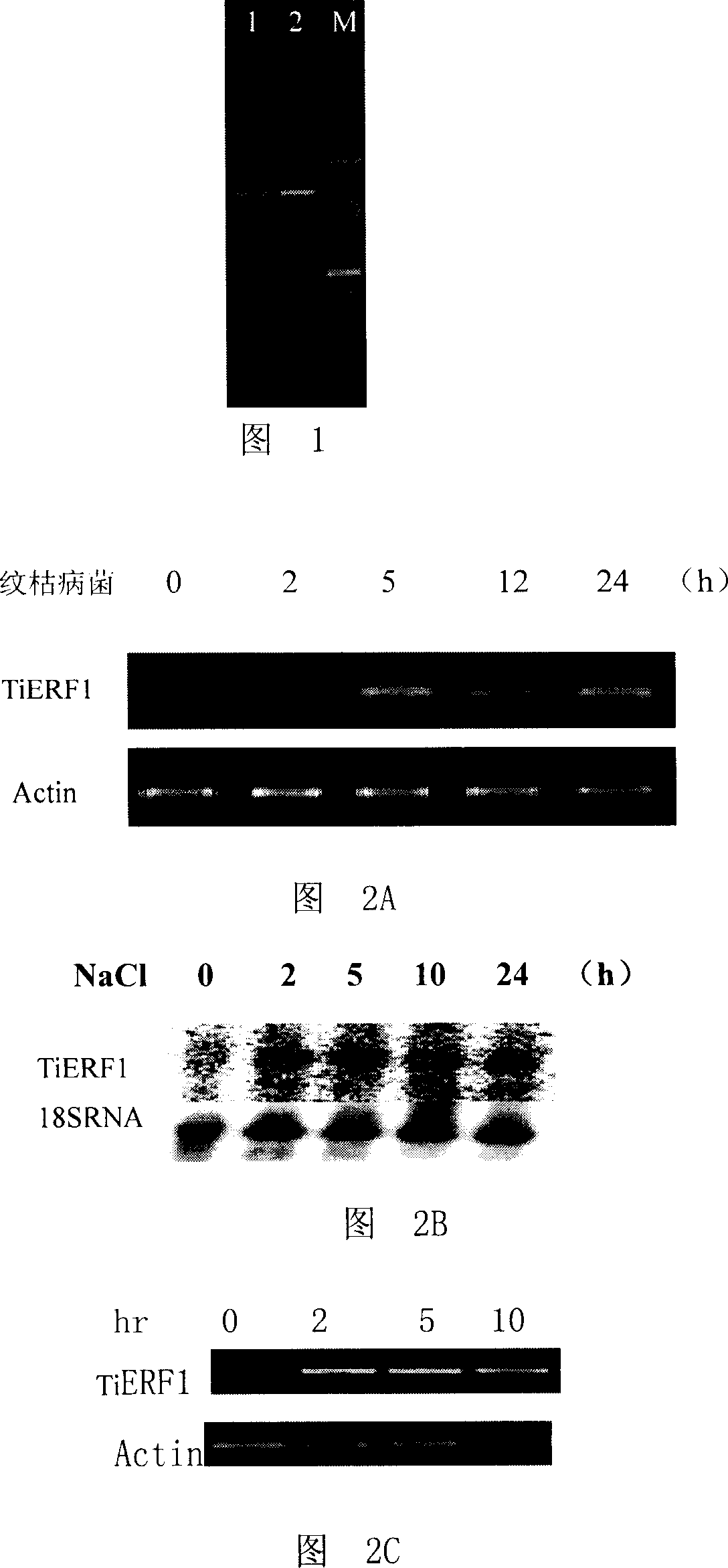Thinopyrum intermedium ERF-transcription factor and its coding gene and use
A technology for transcription factors and coding genes, which can be used in applications, genetic engineering, plant genetic improvement, etc.
- Summary
- Abstract
- Description
- Claims
- Application Information
AI Technical Summary
Problems solved by technology
Method used
Image
Examples
Embodiment 1
[0033] Example 1, Cloning and Sequence Analysis of ERF Transcription Factor Gene of Echinopsis intermedia
[0034] Three weeks of growth at room temperature (26 degrees) for Thiopyrum intermedia, some plants were inoculated with wheat sheath blight bacteria on the leaf sheaths and leaves of Thiopyrum intermedia seedlings by toothpick and friction method, and the roots of some plants were soaked in 250mm NaCl aqueous solution deal with. Take Trizol (Invitrogen) method to extract total RNA from the leaves of Thiopyrum intermedium inoculated with sheath blight for 24 hours or treated with NaCl for 5 hours, dissolved in DEPC water, and detected by agarose gel electrophoresis. Take 5ug of total RNA with good quality and no DNA pollution, and use the Superscript First-Strand Synthesis System for RT-PCR kit (Invitrogen) from Invitrogen Company, and use Oligo d(T) 12-18 As primers, the first strand of cDNA was synthesized according to the kit instructions. According to the wheat EST...
Embodiment 2
[0040] Embodiment 2, the induced expression analysis of TiERF1 gene
[0041] The following stress treatments were carried out on Thiopyrum intermedia: pathogenic bacteria, 250mM NaCl, drought, low temperature, 2mM ethephon solution (ET), and the specific treatment methods were as follows:
[0042] Pathogen treatment: Inoculate wheat sheath blight mycelium on three-week-old Thinopyrum intermedium leaves by rubbing and dental inspection, and take leaves at 0h, 2h, 5h, 12h, and 24h after inoculation, freeze in liquid nitrogen, and store at -70 degree of preservation.
[0043] Salt treatment: the roots of Thiopyrum intermedia plants growing around four weeks were placed in 250mM NaCl aqueous solution, and the leaves were taken after 0h, 2h, 5h, 10h, and 24h, quickly frozen in liquid nitrogen, and stored at -70°C for later use.
[0044] Drought treatment: wash the three-week-old Thiopyrum intermedia seedlings with water, put them on filter paper enough to absorb the water, dehydra...
Embodiment 3
[0048] Embodiment 3, in vitro expression of Tierf1 gene in Escherichia coli
[0049] Design a pair of specific primers according to sequence 1 in the sequence table, and add enzyme recognition sites EcoRI and XhoI at both ends of the upstream and downstream primers. The specific sequences are as follows AP1 5'-CCGAATTCCCGACGACTCCGACGACA-3', AP25'-TTCTCGAGCTAGCTGACCAGCTGCTGC-3 '; Amplify TiERF1 by PCR comprising the AP2 DNA domain and the sequences on both sides to obtain a cDNA fragment of about 700bp, and use EcoRI and XhoI (Takara) to digest the target gene amplification fragment and the fusion protein expression vector PGEX-4T-1 ( purchased from Amersham Company), purify and recover the target gene fragment and vector fragment. by T 4 DNA ligase inserts TiERF1 into the GST site of PGEX-4T-1, then transforms it into E. coli BL21 cells, picks a single colony, cultures, extracts the plasmid, and uses AP1 and AP2 primers for PCR identification and sequencing. The identified ...
PUM
 Login to View More
Login to View More Abstract
Description
Claims
Application Information
 Login to View More
Login to View More - R&D
- Intellectual Property
- Life Sciences
- Materials
- Tech Scout
- Unparalleled Data Quality
- Higher Quality Content
- 60% Fewer Hallucinations
Browse by: Latest US Patents, China's latest patents, Technical Efficacy Thesaurus, Application Domain, Technology Topic, Popular Technical Reports.
© 2025 PatSnap. All rights reserved.Legal|Privacy policy|Modern Slavery Act Transparency Statement|Sitemap|About US| Contact US: help@patsnap.com


